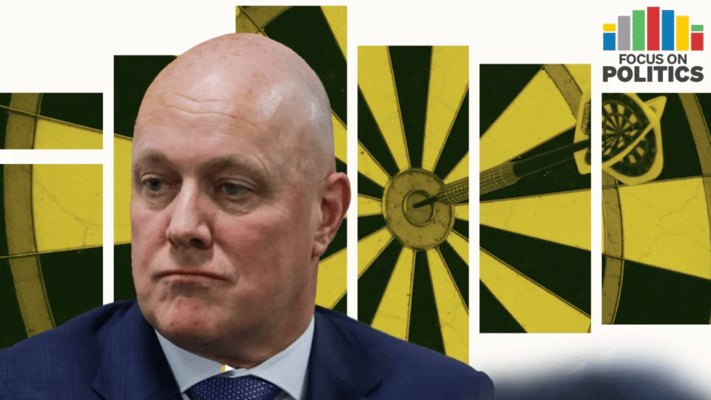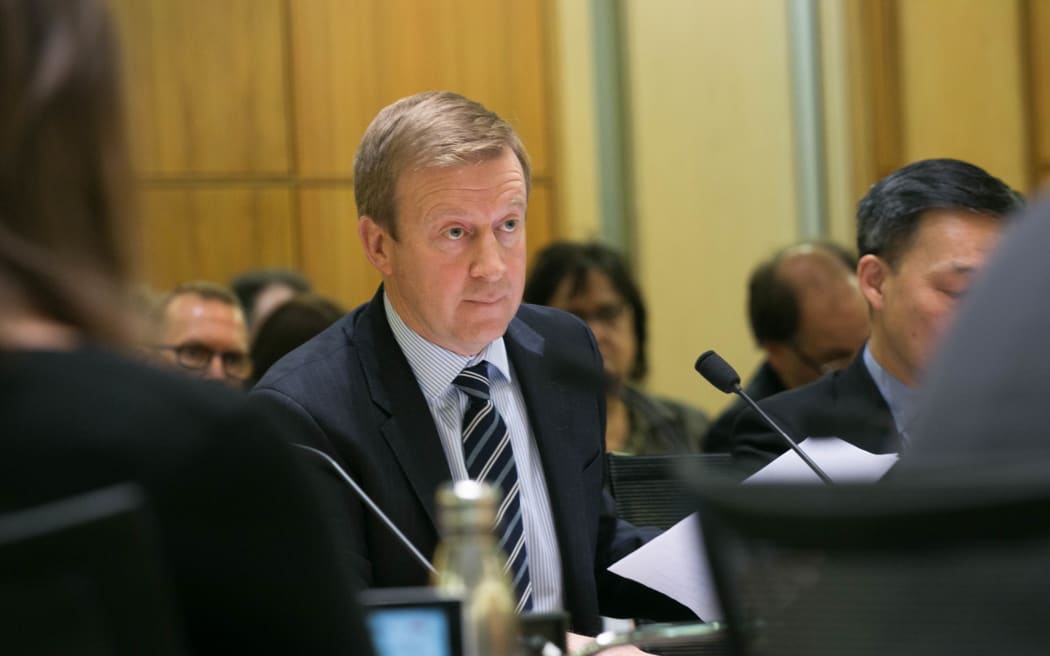Aim & Fire? Public Service Targets Return Amid Job Cuts

"Sometimes you might fall a bit short, but along the way you probably have brought some improvement" - Jonathan Coleman
Public Service Targets are set for a comeback but with job cuts looming over ministries and agencies, unions fear public servants are only being asked to do more with less.
Originally introduced by John Key's National government, the targets have led to improvements in the past - but that experience shows there are also risks.
Prime Minister Christopher Luxon unveiled his latest bullet-point list of deliverables on Monday, a 36-step action plan with a 30 June deadline.
Some can be ticked off with ease - like the 12 commitments to "take decisions", or complete business-as-usual requirements like delivering a Budget. Luxon faced criticism from the opposition of running the country like a company, but he says he's turned around large organisations before - skills he says are transferable to his new role.
Point 26 - the resurrection of public service targets - is certainly in keeping with his chief executive style. It was a cornerstone National Party policy in 2012 launched by then-PM John Key, who touted the need for quantifiable results New Zealanders could understand. The rhetoric and rationale from Luxon 12 years later is much the same.
The 10 original targets aimed for percentage reductions in rheumatic fever, crime rates, assaults on children, and the number of people on a benefit; percentage increases to infant immunisation rates, early childhood education participation, and NCEA and tertiary qualifications; and more online interaction with government services. Each was overseen by a relevant minister and public service chief executive but required cross-agency collaboration.

Dr Jonathan Coleman at a select committee. Photo: VNP / Phil Smith
Dr Jonathan Coleman was state services minister from 2011 to 2014 and says they wanted cohesion, focus, and accountability: that is, getting departments working together, setting outcomes they can be measured against, and making the work of the sector more visible to the public.
Coleman says the targets were always meant to be ambitious, and while not all hit their mark they largely achieved their purpose.
"It was all about actually improving the lives of New Zealanders and so I think without some focus and direction you're not going to bring that about - and these targets certainly did do that."
Read more:
- Prime Minister lays out his priority list for next three months
- Luxon's quarterly action plan 'pointless' - Labour, Greens
- NZ public sector job cuts: what we know so far
- Government departments defend staffing increase in late 2023
- Public servants on edge over wait for final decisions on jobs
The targets were spruced up by Sir Bill English in 2017: more first-trimester lead maternity registrations, fewer children hospitalised, fewer victims of serious crime, better literacy and numeracy at school, and lower wait times for priority-clients' social housing.
Labour accused the government of softening the targets to make them more realistic: for instance, violent crime reduction was shifted from a percentage to a flat number. Despite agreeing with the wider purpose of setting targets, the party scrapped them when in government in 2018.
Victoria University emeritus professor of public policy Jonathan Boston says there are merits and risks to bringing targets back. They set expectations and send signals to the public sector, and most targets did achieve better outcomes - but they can also mean less focus or a deterioration in other areas, particularly where improvements are harder to measure or take longer to achieve.
"Organisations, understandably, focus on the things that are deemed to be important to decision-makers - the ministers in this case - and therefore other things tend to get de-emphasised."
With job cuts looming over departments and agencies, the Public Service Association union is also warning a lack of resourcing could mean public servants are being set up to fail. PSA national secretary Kerry Davies says it's a worry if the targets are narrowly focused and used as a political tool, rather than thoroughly developed as a genuine driver of good outcomes.
"There needs to be careful consideration given to how they're described so that we don't end up with unintended or perverse outcomes because they're so narrowly focused or so ill-written."
Details and timeframes for the new targets remain unclear, but are likely similar to last time - education, law and order, welfare. The government has already set five targets in health.
Luxon wants his government relentlessly focused on outcomes, and while these targets are just one of 36 points over the coming months, they are a crucial measure by which the government will be judged - by itself, and the public.
"Sometimes you might fall a bit short, but along the way you probably have brought some improvement" - Jonathan Coleman
Public Service Targets are set for a comeback but with job cuts looming over ministries and agencies, unions fear public servants are only being asked to do more with less.
...
"Sometimes you might fall a bit short, but along the way you probably have brought some improvement" - Jonathan Coleman
Public Service Targets are set for a comeback but with job cuts looming over ministries and agencies, unions fear public servants are only being asked to do more with less.
Originally introduced by John Key's National government, the targets have led to improvements in the past - but that experience shows there are also risks.
Prime Minister Christopher Luxon unveiled his latest bullet-point list of deliverables on Monday, a 36-step action plan with a 30 June deadline.
Some can be ticked off with ease - like the 12 commitments to "take decisions", or complete business-as-usual requirements like delivering a Budget. Luxon faced criticism from the opposition of running the country like a company, but he says he's turned around large organisations before - skills he says are transferable to his new role.
Point 26 - the resurrection of public service targets - is certainly in keeping with his chief executive style. It was a cornerstone National Party policy in 2012 launched by then-PM John Key, who touted the need for quantifiable results New Zealanders could understand. The rhetoric and rationale from Luxon 12 years later is much the same.
The 10 original targets aimed for percentage reductions in rheumatic fever, crime rates, assaults on children, and the number of people on a benefit; percentage increases to infant immunisation rates, early childhood education participation, and NCEA and tertiary qualifications; and more online interaction with government services. Each was overseen by a relevant minister and public service chief executive but required cross-agency collaboration.

Dr Jonathan Coleman at a select committee. Photo: VNP / Phil Smith
Dr Jonathan Coleman was state services minister from 2011 to 2014 and says they wanted cohesion, focus, and accountability: that is, getting departments working together, setting outcomes they can be measured against, and making the work of the sector more visible to the public.
Coleman says the targets were always meant to be ambitious, and while not all hit their mark they largely achieved their purpose.
"It was all about actually improving the lives of New Zealanders and so I think without some focus and direction you're not going to bring that about - and these targets certainly did do that."
Read more:
- Prime Minister lays out his priority list for next three months
- Luxon's quarterly action plan 'pointless' - Labour, Greens
- NZ public sector job cuts: what we know so far
- Government departments defend staffing increase in late 2023
- Public servants on edge over wait for final decisions on jobs
The targets were spruced up by Sir Bill English in 2017: more first-trimester lead maternity registrations, fewer children hospitalised, fewer victims of serious crime, better literacy and numeracy at school, and lower wait times for priority-clients' social housing.
Labour accused the government of softening the targets to make them more realistic: for instance, violent crime reduction was shifted from a percentage to a flat number. Despite agreeing with the wider purpose of setting targets, the party scrapped them when in government in 2018.
Victoria University emeritus professor of public policy Jonathan Boston says there are merits and risks to bringing targets back. They set expectations and send signals to the public sector, and most targets did achieve better outcomes - but they can also mean less focus or a deterioration in other areas, particularly where improvements are harder to measure or take longer to achieve.
"Organisations, understandably, focus on the things that are deemed to be important to decision-makers - the ministers in this case - and therefore other things tend to get de-emphasised."
With job cuts looming over departments and agencies, the Public Service Association union is also warning a lack of resourcing could mean public servants are being set up to fail. PSA national secretary Kerry Davies says it's a worry if the targets are narrowly focused and used as a political tool, rather than thoroughly developed as a genuine driver of good outcomes.
"There needs to be careful consideration given to how they're described so that we don't end up with unintended or perverse outcomes because they're so narrowly focused or so ill-written."
Details and timeframes for the new targets remain unclear, but are likely similar to last time - education, law and order, welfare. The government has already set five targets in health.
Luxon wants his government relentlessly focused on outcomes, and while these targets are just one of 36 points over the coming months, they are a crucial measure by which the government will be judged - by itself, and the public.









Leave a Comment